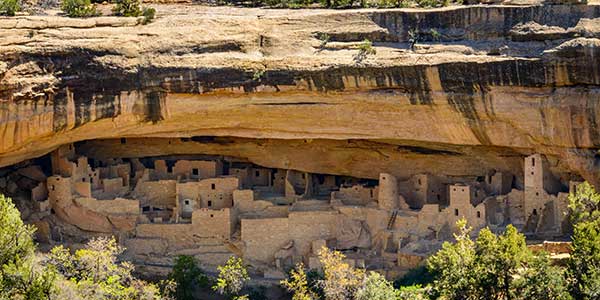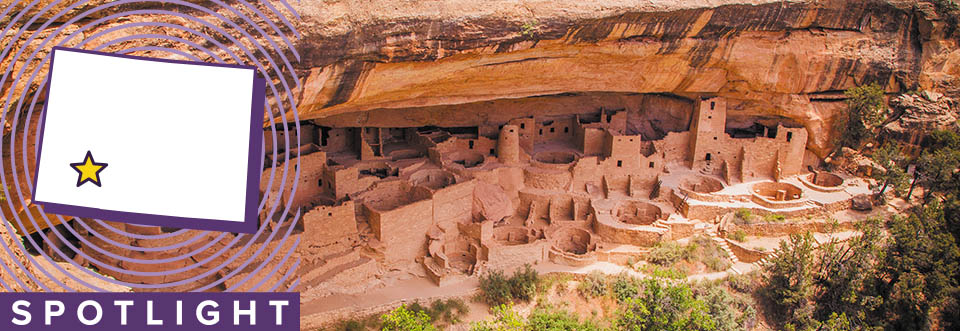Southwest Colorado
Deep gorges and enigmatic cliff dwellings will take your breath away
Explore the dwellings left behind by Native Americans and hike the rugged terrain crafted by nature in Southwest Colorado. From towns that were founded during the Old West era to mountain peaks that soar into the clouds, the vast southwest corner of the Centennial State never fails to dazzle. Below are some must-see destinations for travelers visiting this spectacular stretch of America’s West.
Black Canyon of the Gunnison
Some of nature’s most awe-inspiring landscapes abide in Black Canyon of the Gunnison National Park in western Colorado, just 13 miles east of the town of Montrose. You don’t have to be a mountain goat or thrill-seeking mountain climber to enjoy the outdoors here.
The Black Canyon of the Gunnison National Park encompasses a 14-mile section of the gorge carved by the Gunnison River over the course of millions of years. The gorge plummets 2,722 feet at its deepest point, and some of the canyon’s sides are sheer. The Painted Wall is the highest cliff in Colorado, standing 2,250 feet from river to rim. Because of the depth of the dramatic chasm, some parts of the park receive a scant 33 minutes of sunlight a day.
Where the Wild Things Wander
Wildlife is abundant in Black Canyon, and here you can observe yellow-bellied marmots, mountain cottontails, Rocky Mountain bighorn sheep and, if you’re lucky, the “ghost of the Rockies” — the elusive mountain lion.
After the sun goes down, the elegant and breathtaking beauty of the night sky is revealed. Gather with other stargazers and hear an evening talk by a park ranger or local astronomer, or marvel at the eye-popping display of thousands of stars on your own.
When winter arrives at Black Canyon, don’t let a little (or a lot of) snowfall keep you away. If skiing and snowshoe treks are on your bucket list, check them off here. The South Rim Drive remains unplowed in winter, allowing it to morph into a ski trail. Snowshoe outings are offered at the upper part of the Oak Flat Loop and Rim Rock Trail. The snow-capped outcroppings of the canyon are visible from both points.
The Cedar Point Nature Trail on the South Rim is ideal for viewing local plant life, and two overlooks at the end provide views of the river 2,000 feet below. For a more vigorous hike, try the Chasm View Nature Trail. This moderate route is a 1/3-mile round trip and moves through a pinyon/juniper forest to an overlook that rests 1,800 feet above the river. Swifts, swallows and raptors make frequent appearances over the second overlook, from which the Painted Wall and Serpent Point features can be seen.

Black Canyon History
To the south of the park lies Cimarron, established by settlers in 1883. The town was served by train through the Black Canyon; the locomotive stopped running through the canyon in 1949. The National Park Service maintains a visitor center, campground and picnic are on the site of the former community. While in the area, check out the vintage Sinclair service station near the park’s entrance.
Durango
Just over 100 miles south of Black Canyon via U.S. Route 550 lies the dynamic town of Durango. Snowcapped mountain peaks, roaring waterways and soaring pine trees make this area a picturesque destination. If you add in double doses of recreational activities and historic charm, you’ll be hard-pressed to end your stay here.
Situated along the Animas River, Durango was established by railway companies in 1880. Early visitors weren’t drawn here for the natural beauty of the landscape. Instead they were more interested in what they could find below the surface: silver and gold.
Ride the Rails
Ride into history aboard the Durango & Silverton Narrow Gauge Railroad, first built to transport minerals between Durango and the high mountain town of Silverton. The spirit of the Old West comes alive as you chug along tracks in vintage passenger cars pulled by steam-powered locomotives.
The glass-topped Silver Vista car gives you immersive views of the spectacular landscapes along the route. Look deep in the mountainous ravines formed by the Animas River. Hop off to explore the historic mining town of Silverton, which sits above 9,000 feet in elevation and welcomes visitors with a main street lined with colorful buildings. Meander through the eclectic shops and charming restaurants before returning to Durango.
Drive the Scenic San Juan Skyway
While not for the faint of heart, the San Juan Skyway Scenic Byway leads visitors to Silverton over pavement instead of tracks. This mountainous road twists and turns through stunning scenery. Continue on to the section known as the Million Dollar Highway as you head toward Ouray, where you can explore hot springs and Victorian architecture. While its name refers to the cost to build the road, the priceless views have cemented the highway’s popularity among motorists. At Red Mountain Pass, you’ll reach the pinnacle at 11,000 feet. If you have time for a daytrip, continue the byway’s loop though several charming towns, including Ridgway, Cortez and Telluride. Like the miners who traversed the countryside a century ago, modern visitors can strike gold in this region when aspen tree leaves take on a stunning hue in the autumn, bathing the hillsides in an amber glow.
Explore Durango
Elegant historic buildings rise high above the streets, dwarfed only by the snowcapped mountain peaks in the distance, giving downtown Durango a stunning beauty not found in many other cities. Foodies will love sampling the eclectic menu of restaurants found here. Relax and soak in the atmosphere at one of the microbreweries pouring local craft beers. Vineyards and wineries are growing in popularity in Durango and the surrounding area. Sit on a patio and enjoy some amazing views while sipping local wines. Shops, galleries and more round out the experience.
Nearby, the 7-mile Animas River Trail runs along the rippling river as it makes its way through town. This scenic trail is perfect for those seeking a relaxing walk or some exercise. Benches provide a nice way to sit a spell and do some people-watching. Head off the trail to explore the Durango Fish Hatchery and Wildlife Museum, where feeding the fish is a favorite activity.
Many more adventurous trails can be found in the hills and valleys surrounding Durango. Pick your desired level of difficulty and head to the hills. Hike up Smelter Mountain for expansive views of the city below. The Cascade Creek Trail takes you through a forest of pine trees to a spectacular view of a tumbling waterfall. After a day of hiking and adventuring, sink into the Pinkerton Hot Springs or Trimble Spa and Natural Hot Springs to relax your cares away in one of Mother Nature’s hot tubs.

Mesa Verde
About 40 miles west of Durango, Mesa Verde National Park preserves the amazing legacy of Native American builders. For more than 700 years (from A.D. 600-1300), the Ancestral Puebloans made their homes in the red rock cliffs of southwest Colorado. The natural alcoves provided protection for the structures they built using sandstone bricks, and the ecosystem made farming in the surrounding area possible.
After being abandoned near the end of the 13th century, the ruins remained relatively undisturbed for hundreds of years. In the late 1800s, pioneers began exploring the structures and removing artifacts, leading President Theodore Roosevelt to protect the lands in 1906. The result is the largest archaeological preservation site in America.
To this day, Mesa Verde National Park protects more than 4,700 sites, including 600 cliff dwellings, for which the park is most famous. In the 1930s, the Civilian Conservation Corps helped make these locations more accessible for visitors, making it possible for you to drive by some of the cliff dwellings. The Mesa Top Loop Road offers a short driving tour of a dozen sites and scenic overlooks.
Bring your sunscreen and hiking shoes, along with your camera, when you head to Mesa Verde. The best way to fully experience the park is with a guided tour of a cliff dwelling. On these excursions, national park rangers will share their vast knowledge of the landscape and peoples who lived here.
To fully understand and appreciate what life was like for this region’s early inhabitants, plan a visit to the Mesa Verde Visitor and Research Center, and the Chapin Mesa Archeological Museum. Films, artifacts and dioramas help to tell the story of the Ancestral Puebloans.
For More Information
Southeast Colorado
800-265-6723
www.colorado.com/southeast
Colorado Tourism Office
800-265-6723
www.colorado.com






